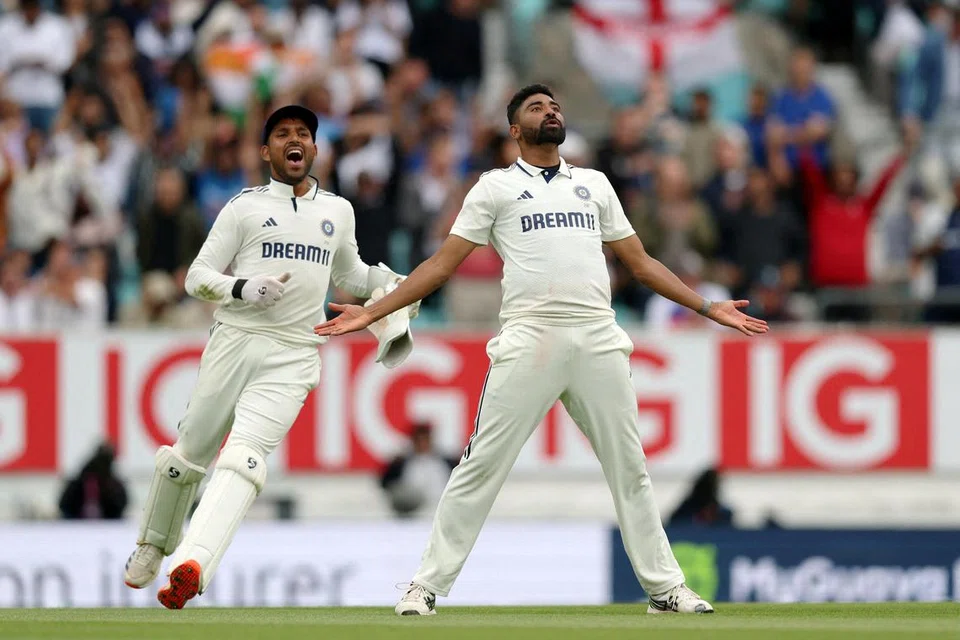It began with 35 runs, four wickets, one arm in a sling – and ended in goosebumps.
India’s six-run victory over England at The Oval in London on Aug 4 wasn’t just a win. It was a roaring statement of intent from a new-look Indian team, a thrilling culmination to a bruising five-Test series and, perhaps most importantly, a powerful reaffirmation of why Test cricket still matters.
This was a contest that could have belonged to either side.
On a sunlit Monday morning in London, with England needing just 35 runs and India hunting four wickets, every ball was charged with electricity. Then came Mohammed Siraj, tearing in with unrelenting fire, clean-bowling Gus Atkinson to spark wild Indian celebrations and level the series 2–2.
For India, this was more than just a win – it was a coming-of-age moment. Under new captain Shubman Gill, still only 25, the team showcased resilience, composure, and an almost stubborn refusal to give up.
With the big three – Rohit Sharma, Virat Kohli, and Jasprit Bumrah – missing in action for large parts of the series, the weight of responsibility shifted. Gill and his young squad responded by delivering one of the most fiercely contested Test series in recent memory.
This wasn’t just about the margin – India’s narrowest ever Test win. It was about the manner.
They were down 2–1 after Manchester, missing key players, facing a surging England side. But they clawed back. They fought. And in doing so, they reminded the cricketing world of the spirit that makes Test cricket unrivalled in drama and depth.
The fifth Test had it all: a rain-hit fourth day, a tactical battle on day five, emotional highs and gut-wrenching lows.
Chris Woakes, unable to bowl due to a dislocated shoulder, came out to bat with one arm in a sling. That image alone – of a one-armed man trying to scamper runs for his country – captured the essence of Test cricket’s emotional power.
Yet, India’s heroes weren’t short in number. Siraj, the tireless workhorse, claimed 5-104 and 23 wickets across the series.
Prasidh Krishna delivered at the death. Dhruv Jurel’s glove work and batting showed maturity beyond his years. And, at the top of it all, Gill – calm, composed, relentless – ended the series with 754 runs, including four centuries. He now stands tall in a lineage that includes Sachin Tendulkar and Kohli at No. 4.
Gill’s leadership, though understated, has been transformative. His quote at the end – “We never give up” – was not bravado. It was a reflection of the gritty, unbreakable character this team has embraced.
They didn’t just play for pride. They played for legacy, for belief, and for each other.
It was fitting that Siraj delivered the final blow. With Bumrah rested, he led the pace attack across five Tests, bowling faster and smarter than ever.
His yorker to Atkinson will enter folklore – a perfect delivery under pressure, a moment frozen in time.
Even England, which came within inches of a famous win, earned plaudits.
Their commitment, particularly from Harry Brook and Joe Root, kept them alive in impossible situations. Captain Ben Stokes rightly called the series “an unbelievable advert for Test cricket.” And he’s spot on.
This series was a reminder – amid all the noise of T20 leagues and four-day Test proposals – that the five-day format remains the sport’s greatest theatre.
The Oval was sold out. Fans stayed till the very end. Commentators lost their voices. And someone even lost their shoes and underwear (literally) in the stands, so wild was the finish.
Administrators should take note. You don’t get this kind of drama in franchise cricket. You don’t get story arcs like a battered India rising to hold the Tendulkar-Anderson Trophy aloft. And you certainly don’t get a one-armed Woakes battling a ferocious Siraj anywhere but here.
This win will be talked about for years. The scoreline – India 2, England 2 – may seem balanced. But in context, it felt like a series won. A young team, without its stars, found its voice under a young captain. They earned respect, not just points.
Tendulkar called it “absolute goosebumps”. Commentator Harsha Bhogle called it “one of the greatest moments in Indian cricket history.”
But perhaps the most telling tribute came from England’s Harry Brook: “This is the most enjoyable series I’ve played in.” High praise from a rival, and a testament to the contest’s intensity.
This was also a reminder of what’s possible when rivalries are built not on bitterness, but on mutual excellence.
There were verbal spats, yes. But there was also a lap of honour, handshakes and heartfelt respect. Even India great Sunil Gavaskar was seen leading a chorus of celebration on the outfield.
India’s win at The Oval is more than a line in a scorebook. It is a love letter to Test cricket. It’s a signal that a post-Kohli, post-Rohit era can still shine bright.
And it’s a promise – from Gill, from Siraj, from every player in that squad – that Test cricket isn’t just alive. It’s thriving.


